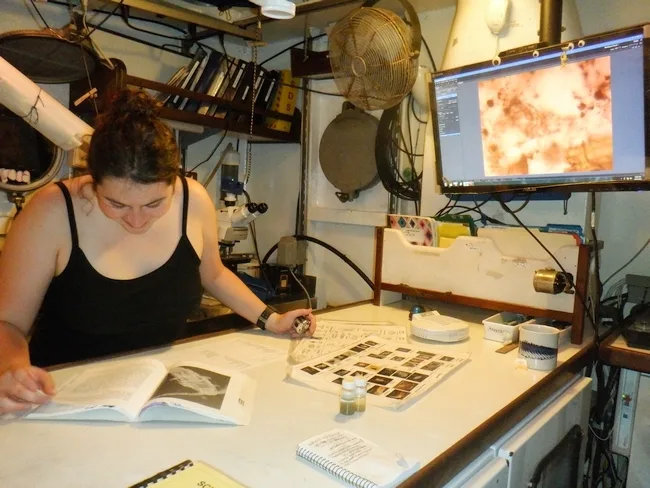News
Ode to Zooplankton

Author: Macy Littell , Starboard/B Watch, Wellesley College
Ship’s Log
Ship’s Position
18°22.408’N 64°56.222’W
Taffrail Log
63.52 nm
Sail Plan
At anchor
Weather
F2 winds SSExSE, waters calm with no swells
Location
Cramer is sleepy today as she rocks back and forth at anchor. We arrived in St. Thomas yesterday after a short sail from Francis Bay, St. John. We still have a little bit of the bay with us, sitting in jars and bottles ready to be processed and analyzed. Two of those bottles are mine, filled with green-brown murky water, a strikingly different color than the rich teal sea they were collected from. Inside my vials, hundreds of plankton swim and float, causing the muddy color.
Two days ago, we conducted a reef survey. At the end of the snorkel, I swam around with a net tow, a large mesh funnel that traps plankton and collects them in a large plastic bottle at the end of the net. Back on Cramer, the contents of the bottle were strained through a sieve to organize them by size. Then the fun began! Our assistant scientist Bonnie carefully walked me through how to prep the slides and connect the microscope to the computer. I put my eyes to the optical piece and peered into a different world.
I saw copepods and diatoms, nauplii and snails. The world of plankton suddenly visible to my eyes. My shipmates excitedly buzzed in and out of the lab, each wanting a turn to peer into this microscopic universe. Once an interesting specimen was in clear focus on the microscope, I would display in on the computer screen. My first glance at the sample was focused on getting a feel for what specimens were present. My next step, which I will be starting today, is to do a hundred count survey. This means I will systematically look through the microscope to identify and record the first one hundred plankton I see.
What can be revealed about the environment by the populations of zooplankton hidden to the naked eye? This is the driving question behind my research project. For the next few days, my shipmates can find me happily glued to the microscope, flipping through guidebooks, excited to learn and identify organisms in this microscopic world.
Identifying the species or family of each organism has always been a passion of mine. This ability to identify a creature unlocks capacity for new levels of understanding that were previously impossible. On a survey, I may spot a fish that I’ve never seen before. I may not know its name or what genus it belongs to, but I can notice its giant eyes, designed for seeing at night. I can hypothesize that its beautiful red scales help it camouflage because red is the first wavelength of light absorbed by water. I can watch it sit under its rock, knowing that it is finding sanctuary in a dark, safe place as it awaits night fall. Then, I can go back to a guidebook, and in a proud moment of discovery, I can find its name: the blackbar soldierfish. This opens the door for even more discovery. I can ask about its diet, its predators, its niche. It becomes more than a colorful fish a reef, it becomes a part of the puzzle that makes up the ecosystem. It transforms from a fleeting sighting on a snorkel trip to species that I care about and want to protect. Soon, I will be asking these same questions about the plankton under my microscope and adding more animals, albeit a tiny ones, to my list of favorite creatures.
– Macy Littell, Starboard/B Watch, Wellesley College
P.S. Mom and Dad, I have learned how to use the compass to face Bhaji for my obligatory prayer and had a small celebration for the centenary of the Ascension of Abdu’l-Baha. I have never felt more connected to “Blessed is the spot…”
Contact: Douglas Karlson, Director of Communications, 508-444-1918 | dkarlson@sea.edu